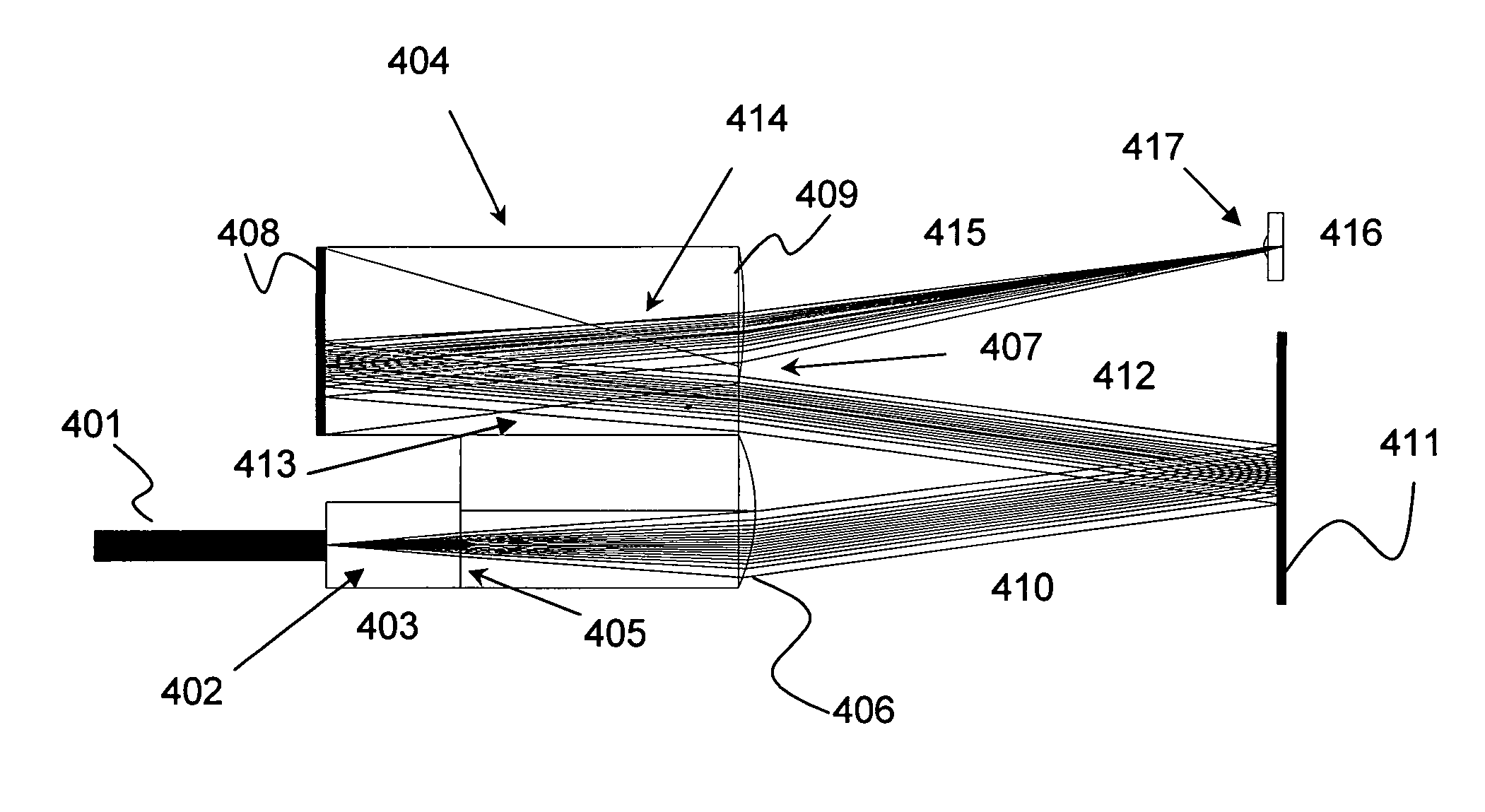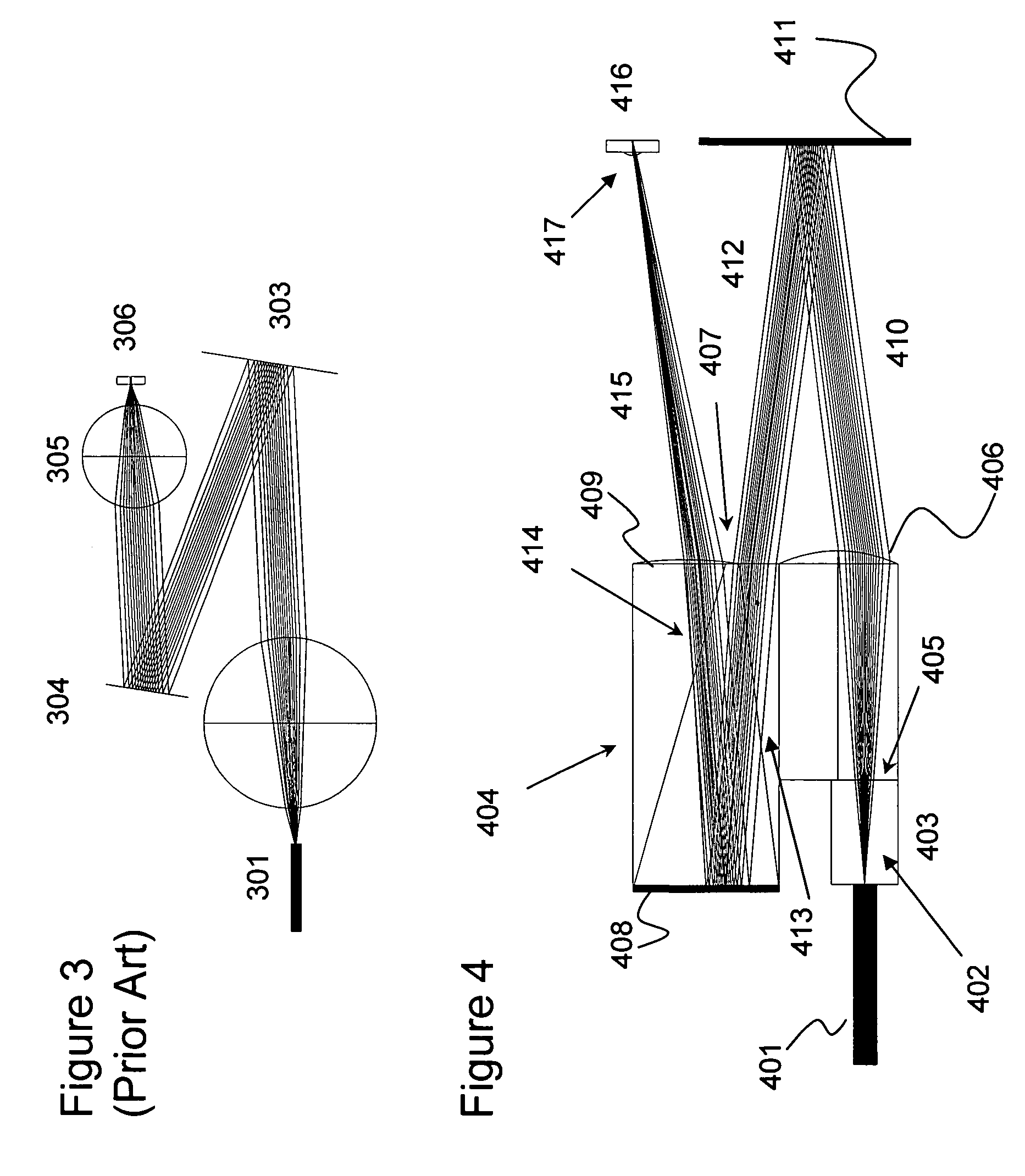High dynamic range integrated receiver
a receiver and dynamic range technology, applied in the direction of photometry using electric radiation detectors, optical radiation measurement, instruments, etc., can solve the problems of increasing packaging size and cost, packaging complexity, size and cost, and dynamic range limitation of optical receivers at low optical input power, so as to simplify the assembly process of hdri rx, reduce size and cost, and facilitate manufacturing
- Summary
- Abstract
- Description
- Claims
- Application Information
AI Technical Summary
Benefits of technology
Problems solved by technology
Method used
Image
Examples
first embodiment
[0030]FIG. 4 illustrates an inline optical layout of an High Dynamic Range Integrated (HDRI) receiver employing a reflective variable optical attenuator (VOA) actuator 411 in accordance with the present invention. A diverging beam 402 launched from an input fiber 401, defining an input port, propagates through a silica block 403 placed in optical contact with the end-face of input fiber 401, and enters the monolithic optical block 404 through an input port defined by a first input planar surface 405, which is also in optical contact with the silica block 403. The silica block 403 has an index of refraction in between that of the input fiber 401 and the optical block 404 providing a gradual transition therebetween for minimizing back reflections from interfaces therebetween. The monolithic optical block 404 integrates five optical interfaces including: in the order of the beam propagation, an input planar surface 405, a collimating lens surface 406, a planar refractive surface 407, a...
second embodiment
[0031]FIG. 5 illustrates an inline optical layout of an HDRI receiver employing a reflective VOA actuator 509 in accordance with the present invention. A diverging optical beam 502 launched from an input fiber 501 propagates through a silica block 503, placed in optical contact with an end-face of the fiber 501, and enters a monolithic optical block 504 through an input port in the form of a first input planar surface 505, which is also in optical contact with the silica block 503. The monolithic optical block 504 integrates four optical interfaces including: in order of beam propagation, an input planar surface 505, a coupling lens surface 506, a planar refractive surface 507, and a planar reflective surface 508. The diverging beam 502 is refracted by the lens surface 506 forming a converging beam 510, which is directed towards the reflective VOA actuator 509 forming a reflected beam 511, i.e. an attenuated beam that includes at least a portion of the converging beam 510. The refle...
third embodiment
[0032]FIG. 6 illustrates an inline optical layout of an HDRI receiver employing a reflective VOA actuator 612 in accordance with the present invention. A diverging beam 602, launched from an input fiber 601, propagates through a silica block 603, placed in optical contact with an end-face of the optical fiber 601, and enters a monolithic optical block 604 through an input port defined by a first input planar surface 605, which is also in optical contact with the silica block 603 for the aforementioned reasons. The monolithic optical block 604 integrates six optical interfaces including in order of beam propagation: the first input planar surface 605, a coupling lens surface 606, a second input planar (refractive) surface 607, first and second planar reflective surfaces 608 and 609, and an output planar refractive surface 610. The diverging beam 602 is refracted by the lens surface 606 forming a converging beam 611, which is directed towards the reflective VOA actuator 612 forming a ...
PUM
 Login to View More
Login to View More Abstract
Description
Claims
Application Information
 Login to View More
Login to View More - R&D
- Intellectual Property
- Life Sciences
- Materials
- Tech Scout
- Unparalleled Data Quality
- Higher Quality Content
- 60% Fewer Hallucinations
Browse by: Latest US Patents, China's latest patents, Technical Efficacy Thesaurus, Application Domain, Technology Topic, Popular Technical Reports.
© 2025 PatSnap. All rights reserved.Legal|Privacy policy|Modern Slavery Act Transparency Statement|Sitemap|About US| Contact US: help@patsnap.com



